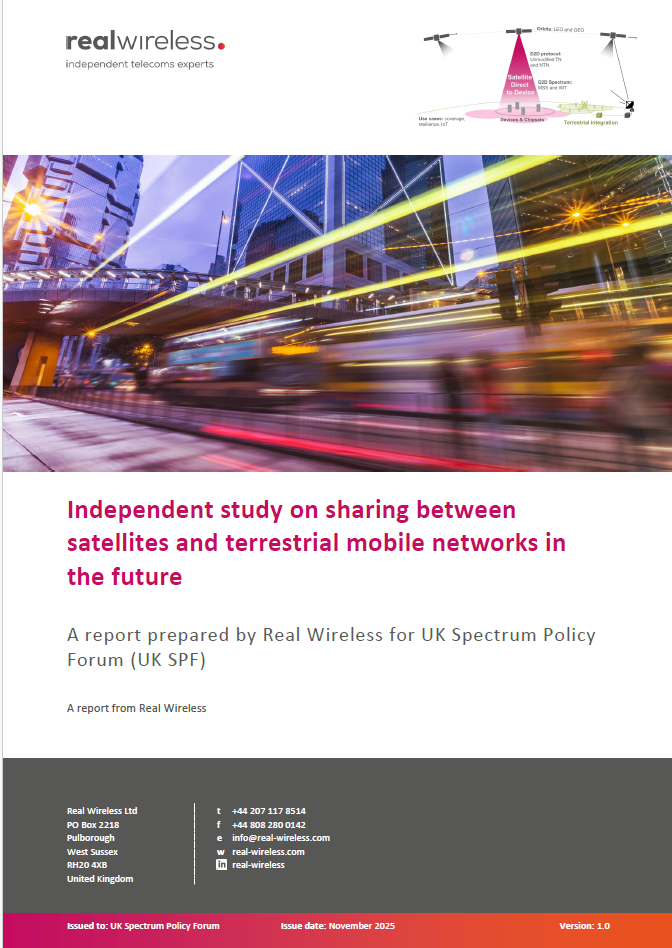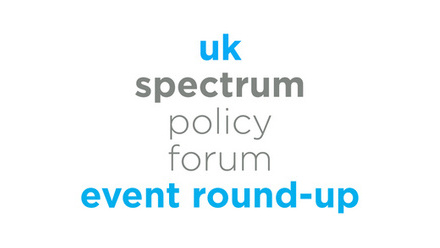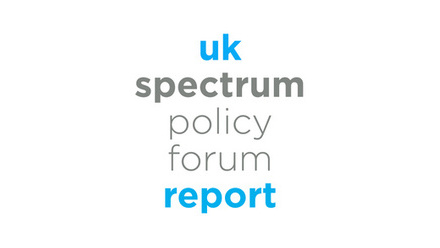UK SPF Report: Sharing between satellites and terrestrial mobile networks in the future
The UK Spectrum Policy Forum (UK SPF) is pleased to announce the publication of an independent report prepared by Real Wireless, titled "Independent Study on Sharing Between Satellites and Terrestrial Mobile Networks in the Future." This timely and forward-looking study explores the evolving relationship between satellite and terrestrial communications, offering valuable insights into how these technologies can coexist and complement each other to meet future connectivity demands.
Commissioned by UK SPF, the report provides a robust evidence base to inform policy, industry strategy, and spectrum planning as the UK and global stakeholders navigate the next generation of integrated telecoms infrastructure.

Log in to read the report
Satellite-Terrestrial Integration: Unlocking the Next Phase of Global Connectivity
The satellite communications industry is entering a pivotal phase of transformation. Traditionally focused on broadcast television and enterprise-grade VSAT broadband, satellite operators are now setting their sights on a much broader and more dynamic market: direct integration with terrestrial mobile networks, particularly through direct-to-device (D2D) services for smartphones and IoT devices. This shift is not merely technological—it represents a strategic realignment of the satellite sector toward mass-market consumer connectivity, driven by evolving user expectations, declining launch costs, and the diminishing relevance of legacy services.
The study highlights how satellite operators are increasingly positioning themselves as complementary partners to terrestrial networks (TNs), rather than competitors. With that in mind, the report provides an overview of the key components of the business case for Direct-to-Device (D2D) Non-Terrestrial Network (NTN) systems.
Key areas of research:
-
Define end-customer use cases and service level expectations (Section 0)
-
Assess spectrum availability and regulatory considerations (Section 3)
-
Evaluate service provider models and Satellite Network Operator (SNO) partnership options (Section 4)
-
Review technology standards and roadmap developments (Section 5)
-
Examine device and chipset requirements and market readiness (Section 6)
-
Analyze system performance and spectrum requirements (Section 6)
-
Summarize overall findings and strategic implications (Section 8)
By enabling coverage in remote or underserved areas, providing resilience during outages, and supporting emergency services and industrial IoT, satellite D2D services can fill critical gaps in the global connectivity landscape. The integration is expected to reduce costs, expand market reach, and justify further investment in satellite infrastructure, particularly in low Earth orbit (LEO) constellations.
Use Cases, Performance Expectations, and Spectrum Needs
Four primary use cases for satellite D2D services emerge from the study: extending coverage to areas where terrestrial networks are not economically viable, enhancing availability for emergency services, maintaining connectivity during terrestrial outages, and supporting IoT applications in sectors such as automotive and industry. These use cases are not only technically feasible but also commercially compelling, especially as satellite backhaul and VSAT systems begin to converge with D2D technologies.
Performance expectations vary significantly depending on the service type. For delay-tolerant applications like messaging and basic IoT, even low data rates in the single-digit kbps range can deliver meaningful value. However, for delay-sensitive services such as voice and video calling, or interactive data use, higher throughput and continuous coverage are essential. The study references 3GPP’s NR-NTN standard, which provides a framework for assessing service quality and spectrum requirements. For example, a 5+5 MHz spectrum allocation can support basic voice and data services with downlink/uplink rates of 155/30 kbps at the cell edge, assuming a best-case scenario with a satellite directly overhead.
Area capacity is another critical factor. To meet ITU’s rural satellite capacity requirement of 8 kbps/km², a 45 km diameter cell would require 30+30 MHz of spectrum. However, higher cell densities—achieved through smaller satellite beam footprints—can reduce spectrum needs. New operators already demonstrate significantly higher cell densities than the 3GPP baseline, suggesting that innovative satellite configurations can help meet performance targets with less spectrum. Nonetheless, worst-case scenarios may yield only half the performance, and current implementations using TN-LTE in IMT bands may not match the spectral efficiency of NR-NTN.
Device Ecosystem and Spectrum Implications
The success of satellite D2D services hinges not only on network performance but also on device and chipset compatibility. The terrestrial mobile ecosystem is deeply rooted in the 3GPP standards framework, which fosters a competitive and interoperable supply chain. While proprietary solutions offer agility, they lack scalability and long-term sustainability. In contrast, standards-based approaches enable for broader market access and device compatibility.
Spectrum access remains a major challenge. While 85% of MSS bands between 1.4 and 2.6 GHz are now standardised for NTN operation, D2D use in IMT bands will require international regulatory coordination. This is particularly important given the limited availability of spectrum and the need to avoid interference with terrestrial networks. Partnerships between mobile network operators (MNOs) and satellite network operators (SNOs) will be essential to navigate these complexities and unlock the full potential of satellite D2D services.
Conclusion
This study paints a compelling picture of a satellite industry in transition—one that is increasingly intertwined with terrestrial mobile networks and poised to deliver critical connectivity services to consumers and enterprises alike. As standards evolve, spectrum challenges are addressed, and partnerships deepen, satellite D2D integration could become a cornerstone of global digital infrastructure, ensuring that no device, user, or location is left behind.

Tales Gaspar
Tales has a background in law and economics, with previous experience in the regulation of new technologies and infrastructure.

Sophie Greaves
Sophie Greaves is Associate Director for Digital Infrastructure at techUK, overseeing the Communications Infrastructure and Services Programme at techUK, and the UK Spectrum Policy Forum.




